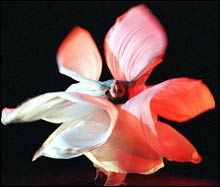 Jody Sperling enters the space tentatively for Cheap. Wearing biker shorts and a skimpy T-shirt, she tiptoes around the edge of a spotlit circle before planting herself in its glare. An ancient movie projector is ratcheting and wheezing somewhere in the distance. Sperling gathers her nerve for a series of small acrobatic tricks and contortions, ending each one with an embarrassed flourish. Is she performing for a camera? Or has she already been filmed and edited?
Jody Sperling enters the space tentatively for Cheap. Wearing biker shorts and a skimpy T-shirt, she tiptoes around the edge of a spotlit circle before planting herself in its glare. An ancient movie projector is ratcheting and wheezing somewhere in the distance. Sperling gathers her nerve for a series of small acrobatic tricks and contortions, ending each one with an embarrassed flourish. Is she performing for a camera? Or has she already been filmed and edited?
Sperling’s Time Lapse Dance performance last Friday at the Cambridge Multicultural Arts Center paid tribute to a bygone generation’s popular entertainers. Sperling’s muse, Loie Fuller, symbolized the first wave of modern culture, which foamed up from the convergence of art, technology, and urbanism at the turn of the 20th century.
Melding the provocative skirt dancing of the music hall with the highbrow æsthetics of poetry and music, Fuller became an Art Nouveau icon. Countless paintings, graphics, sculptures, and kitschy objects — and a few blurry photographs and films — depict the illusions she created on the stage with nothing more than innovative lighting and yards of skillfully manipulated silk.
Jody Sperling re-creates the sumptuous imagery of Fuller’s dance. She also draws on the artful physicality and naive exhibitionism that made its way into circuses, variety shows, and early films. In Hoop Solo, a premiere, she added one and then another hoop and eventually rotating all three of them at the same time by undulating parts of her body.
The entire evening looked surprisingly postmodern, not like a dusty historical souvenir at all. The opening La Nuit was inspired by photos of Fuller’s 1896 dance. Enveloped in black gauze and blue light, Sperling swirled through the space, gradually removing one layer of the costume. Underneath, she wore another diaphanous garment, an elegant red ball gown with spangles. As she spun, the costume billowed out around her like a swale of ribbon candy. The lights subtly changed and I realized with a shock that the dress was black.
After surrounding herself with a halo of circling backbends, she slowly divested herself of the glamorous costume and performing persona. Stripped down to a leather two-piece bathing suit and sunglasses, she dropped the last layer of gauze on the floor like laundry. Later I learned that La Nuit came from dances Fuller originally made for a production of Salome.
Sperling’s smart postmodernism extended past the obvious updatings provided by her wardrobe. She performed matter-of-factly, not trying to conceal the mechanics of untying and dismantling the very costume with which she was making visual magic. She used John Cage’s 1948 In a Landscape as accompaniment.
The evening’s pièce de résistance, Dance of the Elements, was a five-part suite based on Fuller images. Sperling began by showing the audience the thin plastic rods that were constructed into her mantle of white silk to make the voluminous fabric behave as she commanded. She stepped forward, opening her arms and spreading the silk into giant wings. From there the silk metamorphosed into ripples, spirals, wavelets, flames and serpentines — shapes evoking the constant, curving motion of natural forms — as Sperling ran with it, tossed it up and gathered it in, filling the whole space with musical designs.
When we look at pictures of Loie Fuller and the art work she inspired, we see only static images. What’s so extraordinary about Sperling’s work is how expertly she and her collaborators, costume designer Michelle Ferranti and lighting designer Jason Ries, have brought them back to life.
As a bonus, Karen Krolak, director of Boston’s Monkeyhouse Dance, performed her solo Idolum. Krolak cowered and poked out from the safety of a long wispy dress and a floppy hat. Like Sperling, she played a shy person trapped inside a body that loves extravagance.